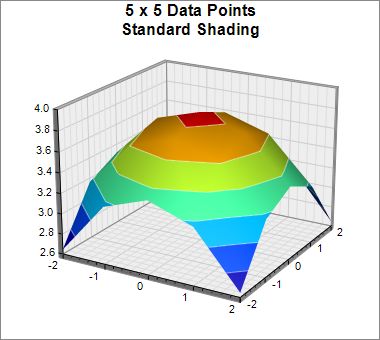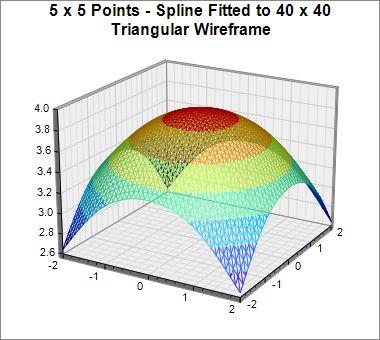





This example demonstrates the rectangular and triangular wireframes of a surface at different interpolation levels, configured using SurfaceChart.setShadingMode and SurfaceChart.setInterpolation.
ChartDirector 6.0 (Perl Edition)
Surface Wireframe






Source Code Listing
#!/usr/bin/perl
# In the sample code, the ChartDirector for Perl module is assumed to be in "../lib"
use File::Basename;
use lib (dirname($0)."/../lib") =~ /(.*)/;
use perlchartdir;
sub createChart
{
my $chartIndex = shift;
# The x and y coordinates of the grid
my $dataX = [-2, -1, 0, 1, 2];
my $dataY = [-2, -1, 0, 1, 2];
# The values at the grid points. In this example, we will compute the values using the formula z
# = square_root(15 - x * x - y * y).
my $dataZ = [(0) x (scalar(@$dataX) * scalar(@$dataY))];
for(my $yIndex = 0; $yIndex < scalar(@$dataY); ++$yIndex) {
my $y = $dataY->[$yIndex];
for(my $xIndex = 0; $xIndex < scalar(@$dataX); ++$xIndex) {
my $x = $dataX->[$xIndex];
$dataZ->[$yIndex * scalar(@$dataX) + $xIndex] = sqrt(15 - $x * $x - $y * $y);
}
}
# Create a SurfaceChart object of size 380 x 340 pixels, with white (ffffff) background and grey
# (888888) border.
my $c = new SurfaceChart(380, 340, 0xffffff, 0x888888);
# Demonstrate various wireframes with and without interpolation
if ($chartIndex == 0) {
# Original data without interpolation
$c->addTitle("5 x 5 Data Points\nStandard Shading", "arialbd.ttf", 12);
$c->setContourColor(0x80ffffff);
} elsif ($chartIndex == 1) {
# Original data, spline interpolated to 40 x 40 for smoothness
$c->addTitle("5 x 5 Points - Spline Fitted to 40 x 40\nStandard Shading", "arialbd.ttf", 12)
;
$c->setContourColor(0x80ffffff);
$c->setInterpolation(40, 40);
} elsif ($chartIndex == 2) {
# Rectangular wireframe of original data
$c->addTitle("5 x 5 Data Points\nRectangular Wireframe");
$c->setShadingMode($perlchartdir::RectangularFrame);
} elsif ($chartIndex == 3) {
# Rectangular wireframe of original data spline interpolated to 40 x 40
$c->addTitle("5 x 5 Points - Spline Fitted to 40 x 40\nRectangular Wireframe");
$c->setShadingMode($perlchartdir::RectangularFrame);
$c->setInterpolation(40, 40);
} elsif ($chartIndex == 4) {
# Triangular wireframe of original data
$c->addTitle("5 x 5 Data Points\nTriangular Wireframe");
$c->setShadingMode($perlchartdir::TriangularFrame);
} else {
# Triangular wireframe of original data spline interpolated to 40 x 40
$c->addTitle("5 x 5 Points - Spline Fitted to 40 x 40\nTriangular Wireframe");
$c->setShadingMode($perlchartdir::TriangularFrame);
$c->setInterpolation(40, 40);
}
# Set the center of the plot region at (200, 170), and set width x depth x height to 200 x 200 x
# 150 pixels
$c->setPlotRegion(200, 170, 200, 200, 150);
# Set the plot region wall thichness to 5 pixels
$c->setWallThickness(5);
# Set the elevation and rotation angles to 20 and 30 degrees
$c->setViewAngle(20, 30);
# Set the data to use to plot the chart
$c->setData($dataX, $dataY, $dataZ);
# Output the chart
$c->makeChart("surfacewireframe$chartIndex.jpg")
}
createChart(0);
createChart(1);
createChart(2);
createChart(3);
createChart(4);
createChart(5); |
#!/usr/bin/perl
# In the sample code, the ChartDirector for Perl module is assumed to be in "../lib"
use File::Basename;
use lib (dirname($0)."/../lib") =~ /(.*)/;
use perlchartdir;
# Get HTTP query parameters
use CGI;
my $query = new CGI;
# This script can draw different charts depending on the chartIndex
$chartIndex = int($query->param("img"));
# The x and y coordinates of the grid
my $dataX = [-2, -1, 0, 1, 2];
my $dataY = [-2, -1, 0, 1, 2];
# The values at the grid points. In this example, we will compute the values using the formula z =
# square_root(15 - x * x - y * y).
my $dataZ = [(0) x (scalar(@$dataX) * scalar(@$dataY))];
for(my $yIndex = 0; $yIndex < scalar(@$dataY); ++$yIndex) {
my $y = $dataY->[$yIndex];
for(my $xIndex = 0; $xIndex < scalar(@$dataX); ++$xIndex) {
my $x = $dataX->[$xIndex];
$dataZ->[$yIndex * scalar(@$dataX) + $xIndex] = sqrt(15 - $x * $x - $y * $y);
}
}
# Create a SurfaceChart object of size 380 x 340 pixels, with white (ffffff) background and grey
# (888888) border.
my $c = new SurfaceChart(380, 340, 0xffffff, 0x888888);
# Demonstrate various wireframes with and without interpolation
if ($chartIndex == 0) {
# Original data without interpolation
$c->addTitle("5 x 5 Data Points\nStandard Shading", "arialbd.ttf", 12);
$c->setContourColor(0x80ffffff);
} elsif ($chartIndex == 1) {
# Original data, spline interpolated to 40 x 40 for smoothness
$c->addTitle("5 x 5 Points - Spline Fitted to 40 x 40\nStandard Shading", "arialbd.ttf", 12);
$c->setContourColor(0x80ffffff);
$c->setInterpolation(40, 40);
} elsif ($chartIndex == 2) {
# Rectangular wireframe of original data
$c->addTitle("5 x 5 Data Points\nRectangular Wireframe");
$c->setShadingMode($perlchartdir::RectangularFrame);
} elsif ($chartIndex == 3) {
# Rectangular wireframe of original data spline interpolated to 40 x 40
$c->addTitle("5 x 5 Points - Spline Fitted to 40 x 40\nRectangular Wireframe");
$c->setShadingMode($perlchartdir::RectangularFrame);
$c->setInterpolation(40, 40);
} elsif ($chartIndex == 4) {
# Triangular wireframe of original data
$c->addTitle("5 x 5 Data Points\nTriangular Wireframe");
$c->setShadingMode($perlchartdir::TriangularFrame);
} else {
# Triangular wireframe of original data spline interpolated to 40 x 40
$c->addTitle("5 x 5 Points - Spline Fitted to 40 x 40\nTriangular Wireframe");
$c->setShadingMode($perlchartdir::TriangularFrame);
$c->setInterpolation(40, 40);
}
# Set the center of the plot region at (200, 170), and set width x depth x height to 200 x 200 x 150
# pixels
$c->setPlotRegion(200, 170, 200, 200, 150);
# Set the plot region wall thichness to 5 pixels
$c->setWallThickness(5);
# Set the elevation and rotation angles to 20 and 30 degrees
$c->setViewAngle(20, 30);
# Set the data to use to plot the chart
$c->setData($dataX, $dataY, $dataZ);
# Output the chart
binmode(STDOUT);
print "Content-type: image/jpeg\n\n";
print $c->makeChart2($perlchartdir::JPG); |